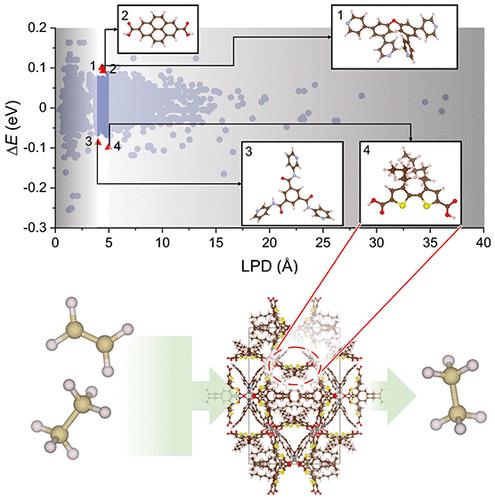当前位置:
X-MOL 学术
›
J. Phys. Chem. Lett.
›
论文详情
Our official English website, www.x-mol.net, welcomes your
feedback! (Note: you will need to create a separate account there.)
Data-Driven Discovery of Gas-Selective Organic Linkers in Metal–Organic Frameworks for the Separation of Ethylene and Ethane
The Journal of Physical Chemistry Letters ( IF 4.8 ) Pub Date : 2024-04-26 , DOI: 10.1021/acs.jpclett.4c00860 Mingzheng Zhang 1 , Qiming Xie 1 , Zhuozheng Wang 2 , Wentao Zhang 1 , Yawen Bo 2 , Zhiying Zhang 1 , Hao Li 2 , Yi Luo 2 , Qihan Gong 2 , Shunning Li 1 , Feng Pan 1
The Journal of Physical Chemistry Letters ( IF 4.8 ) Pub Date : 2024-04-26 , DOI: 10.1021/acs.jpclett.4c00860 Mingzheng Zhang 1 , Qiming Xie 1 , Zhuozheng Wang 2 , Wentao Zhang 1 , Yawen Bo 2 , Zhiying Zhang 1 , Hao Li 2 , Yi Luo 2 , Qihan Gong 2 , Shunning Li 1 , Feng Pan 1
Affiliation

|
Metal–organic frameworks (MOFs) are potential candidates for gas-selective adsorbents for the separation of an ethylene/ethane mixture. To accelerate material discovery, high-throughput computational screening is a viable solution. However, classical force fields, which were widely employed in recent studies of MOF adsorbents, have been criticized for their failure to cover complicated interactions such as those involving π electrons. Herein, we demonstrate that machine learning force fields (MLFFs) trained on quantum-chemical reference data can overcome this difficulty. We have constructed a MLFF to accurately predict the adsorption energies of ethylene and ethane on the organic linkers of MOFs and discovered that the π electrons from both the ethylene molecule and the aromatic rings in the linkers could substantially influence the selectivity for gas adsorption. Four kinds of MOF linkers are identified as having promise for the separation of ethylene and ethane, and our results could also offer a new perspective on the design of MOF building blocks for diverse applications.
中文翻译:

数据驱动的金属有机框架中气体选择性有机连接体的发现,用于分离乙烯和乙烷
金属有机骨架(MOF)是用于分离乙烯/乙烷混合物的气体选择性吸附剂的潜在候选者。为了加速材料发现,高通量计算筛选是一个可行的解决方案。然而,最近在 MOF 吸附剂研究中广泛采用的经典力场因其未能涵盖复杂的相互作用(例如涉及 π 电子的相互作用)而受到批评。在这里,我们证明了在量子化学参考数据上训练的机器学习力场(MLFF)可以克服这个困难。我们构建了一个MLFF来准确预测乙烯和乙烷在MOFs有机连接体上的吸附能,并发现来自乙烯分子和连接体中芳环的π电子可以显着影响气体吸附的选择性。四种 MOF 连接体被认为有望分离乙烯和乙烷,我们的结果也可以为不同应用的 MOF 构建块的设计提供新的视角。
更新日期:2024-04-26
中文翻译:

数据驱动的金属有机框架中气体选择性有机连接体的发现,用于分离乙烯和乙烷
金属有机骨架(MOF)是用于分离乙烯/乙烷混合物的气体选择性吸附剂的潜在候选者。为了加速材料发现,高通量计算筛选是一个可行的解决方案。然而,最近在 MOF 吸附剂研究中广泛采用的经典力场因其未能涵盖复杂的相互作用(例如涉及 π 电子的相互作用)而受到批评。在这里,我们证明了在量子化学参考数据上训练的机器学习力场(MLFF)可以克服这个困难。我们构建了一个MLFF来准确预测乙烯和乙烷在MOFs有机连接体上的吸附能,并发现来自乙烯分子和连接体中芳环的π电子可以显着影响气体吸附的选择性。四种 MOF 连接体被认为有望分离乙烯和乙烷,我们的结果也可以为不同应用的 MOF 构建块的设计提供新的视角。


















































 京公网安备 11010802027423号
京公网安备 11010802027423号